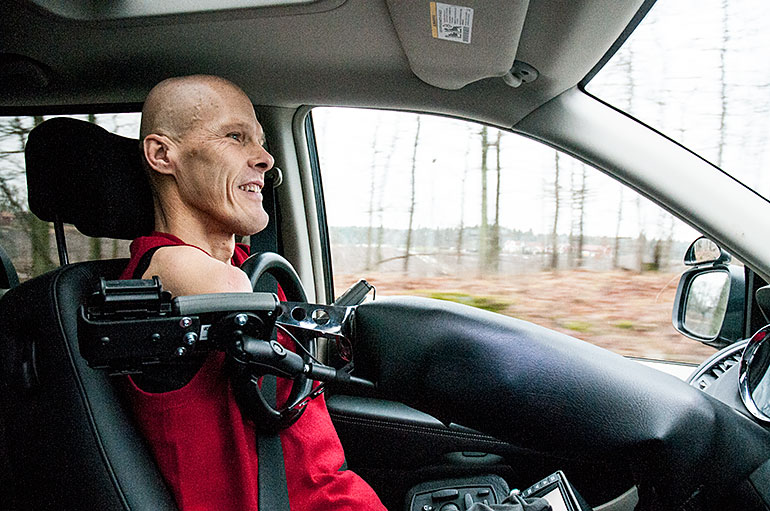
Armless, legless but never hopeless
Former Autoadapt employee is the embodiment of willpower, the only power that really matters when it comes to overcoming obstacles.
When Mikael was born without arms and legs at the regional hospital in Örebro a little over 40 years ago the doctors told his parents: ”You should probably forget this boy. He won’t even be able to sit by himself”.
This sincere advice that was given to his parents was based on what at the time was considered to be the right thing; children with similar special needs would be a lot better off living at an institution. But Mikael’s parents felt different and fought to bring their child home. Eventually they succeeded.
Today Mikael has won many fights and continues to fight for the rights of himself and his peers. As an inspirational speaker he travels the country giving lectures in the awesome power of the mind.
Here at Autoadapt we had the privilege to adapt his car.
 My vehicle adaptation
My vehicle adaptation
Mikael Andersson, Sweden
What type of vehicle do you drive and how is it adapted for you?
"I have a BraunAbility Entervan with a mechanical steering system and a number of different adaptations such as lightened power steering, a seat belt adaptation, moved electrical functions, a more bucketed seat and a wheelchair lock etcetera. Perhaps the most eye catching adaptation is the steering wheel and pedals. Since I don’t have any arms or legs we’ve moved all the controls closer to me. Apart from the steering the one thing that really makes me an independent driver is the lowered floor. It gives me the freedom to enter and exit my car as I want."
How did you come up with this solution?
"Growing up I spent a lot of time with my father in his car, I observed and thought about what I would need to be able to drive. When I later decided to get a driver’s licence I had already drawn up the necessary adaptations in my head. The adaptations I have today are pretty much the same as I got back in 1983. The real change is that everything is better and safer. Back then an adaptation could be a bent metal bar fixed dangerously close to my body in order to move some mechanical function. Today you wouldn’t even consider that sort of thing."
Is this your first adapted vehicle?
"No, this will be my fourth."
What will be the main difference for you with this new adaptation?
"When it comes down to the actual functions there aren’t really any drastic changes. The main difference is as I’ve said, in safety and ergonomics. For instance we’ve improved the way the steering wheel collapses in the case of a crash, also the lock that keeps my powered wheelchair secured has been improved a lot.
I came really close to choosing an electronic steering system but in the end I went with the mechanical solution. I don’t really have anything bad to say about electronic steering systems but I personally feel that I don’t have the same connection to the road as I do with a mechanical system. At the same time I know having the steering wheel close to my body isn’t really optimal either but in the end it all comes down to making choices. I spend a lot of time on the road and whether I’m driving my kids to school; overtaking a truck on the highway or driving on icy roads I feel more comfortable doing it mechanically rather than trusting it to electronics.
Oh! I have an automatic hatch opener, I’ve never had that before and I really look forward to put things in the trunk by myself."
If you could choose freely where in the world would you take your adapted vehicle?
"Australia! I’d really love to go there. Partly because I would like to experience driving on the left side of the road but also because of the varying scenery in Australia."

Göteborg Open 2013
Another year has passed and yet another Göteborg Open was added to the books in a parade of sports, happiness and a strong sense of community. For the 28th consecutive year, the competition has grown even greater, with more and more participants and new sports. There is no question that the recruiting contest Gothenburg Open is the pinnacle of children and youth competitions in Sweden.
To make it as simple as possible for everyone to try out everything, Göteborg Open has simplified the rules in a number of sports. In swimming, parallel slalom, the 60 meter races and riding the winner is not the one who is the fastest or the finish line first, but the one that is most consistent in both heats.
"We don’t want any fuss with medical certificates and classification, we’d rather give everyone the opportunity to try new sports." explains Janne Petersson and continues, "It also provides us with the opportunity to get spontaneous participants in the form of youngsters who perhaps come for the air gun shooting but decide to also try out a new sport while they’re here."
Independence the restaurant
One of the new improvements in 2013 was Autoadapt's own restaurant "Independence". With so many competitors and spectators at the same place it has always been a problem to keep the energy levels charged and the little kitchen in Lundbystrandshallen simply hasn’t been enough. "When Janne mentioned the food issue, I immediately felt it was something that we could help to improve." replies Harald Freytag, Marketing Manager at Autoadapt. "Together with the caterers that we use for our own events, we created the restaurant Independence where you could eat good food at subsidised prices."
Göteborg Open 2014-2015
Next year will be the 29th consecutive year and the competition is expected to grow even larger. Plans are already underway to introduce new sports including wheelchair freestyle. Göteborg Open 2014 will also be the dress rehearsal for the big 30 year anniversary in 2015 which is predicted to become a major event in disability sport.
A Christmast gift from Autoadapt
We belive that our money is better spent on those in need,
our only gift this year will go to UNICEF indeed.